2023-03-02 - Nº 409
Editorial
Esta é a Newsletter Nº 409 que se apresenta com o mesmo formato que as anteriores. Se gostar da Newsletter partilhe-a!
Todas as Newsletters encontram-se indexadas no link.
Esta Newsletter tem os seguintes tópicos:
Faz hoje anos que nascia, em 1862, o físico e sismólogo russo Boris Borisovich Golitsyn. Ele desenvolveu métodos e instrumentos científicos para a observação de terramotos e prospecção mineral. Os seus primeiros estudos foram em física molecular, física matemática e electromagnetismo, A partir de 1899 os seus interesses voltaram-se para a sismologia. Em 1906, inventou o primeiro sismógrafo electromagnético eficaz e continuou a melhorá-lo. Tinha um pêndulo com uma bobina de fio isolado à volta de um núcleo magnético fixado ao solo. A pequena corrente gerada na bobina pelo movimento relativo causado por tremores de terra é amplificada para operar um gravador de caneta. A parte do manto terrestre a uma profundidade de 400-800 km, na qual as ondas sísmicas viajam rapidamente, é denominada a camada de Golitsyn em reconhecimento do seu trabalho.
Faz também hoje anos que nascia, em 1887, o serralheiro e inventor americano Harry E. Soref. Ele patenteou o cadeado de aço laminado, e fundador da Master Lock Company (1921). Como serralheiro, Soref tinha-se apercebido de que os cadeados mais baratos, feitos com lâminas de metal estampado, eram de pouca segurança, pois eram facilmente danificados. Ele patenteou (1924) a sua invenção de um cadeado laminado que, tal como as portas de cofre de banco e os navios de guerra, foi construído em laminados de camada sobre camada de aço para maior resistência. Incapaz de vender a sua invenção a um fabricante de cadeados, ele próprio começou a fabricá-los. O Master Lock abriu a sua primeira pequena fábrica em Milwaukee, Wisc. Em 1928 Master Lock ganhou reconhecimento nacional pelo envio de 147.600 cadeados a agentes federais de proibição em Nova Iorque por terem trancado os speakeasies que invadiram.
Faz igualmente hoje anos que nascia, em 1902, o físico americano Edward U. Condon. Ele é recordado pelo princípio Franck-Condon (1928), desenvolvimento de radar e contribuição para a concepção de equipamento de separação magnética posteriormente aplicado ao processamento de urânio para bombas atómicas. O princípio Franck-Condon (1928) é um tratamento quântico-mecânico da afirmação anterior de James Franck (1925) de que em qualquer sistema molecular a transição de um estado energético para outro ocorre de forma tão próxima a instantânea que os núcleos dos átomos envolvidos são estacionários. Durante o projecto de Manhattan, ajudou J. Robert Oppenheimer a reunir a equipa de cientistas que criou as primeiras bombas atómicas em Los Alamos, N.M. Ele liderou um estudo científico sobre OVNI's, que não encontrou provas credíveis.
Faz também hoje anos que nascia, em 1908, o engenheiro electrotécnico alemão Walter Bruch. Ele inventou o sistema de televisão a cores Phase Alternating Line (PAL) adoptado na Europa. Numa viagem à América em 1953, encontrou insuficiências no sistema tal como ali se desenvolveu pela primeira vez (NTSC, National Television Standards Committee). Regressou ao empregador alemão, Telefunken, e pesquisou uma forma de melhorar a estabilidade das cores sem necessidade de controlos de tonalidade e tonalidade. Em 1961, foi registada uma patente preliminar, mas foi superada em 30 de Dezembro de 1962 com uma versão definitiva do sistema PAL. Seguiu-se uma luta para ser reconhecido como o melhor método de codificação. A Grã-Bretanha seleccionou o PAL como superior ao NTSC e introduziu-o a 1 de Julho de 1967. Seguiu-se a Alemanha, a 25 de Agosto de 1967. Eventualmente, também a maior parte do mundo.
Por fim, faz hoje anos que nascia, em 1913, o físico soviético Georgy Nikolaevich Flerov. Ele reconheceu que o urânio sofre fissão espontânea (sem necessidade de bombardeamento de neutrões). Ele foi um dos primeiros investigadores russos da fissão nuclear. No início de 1942, Flerov notou que os artigos sobre fissão nuclear já não apareciam nas revistas ocidentais. Reconhecendo a implicação de que tal investigação se tinha tornado secreta, Flerov escreveu ao Premier Joseph Stalin, insistindo que "devemos construir a bomba de urânio sem demora", (posteriormente liderado por Igor V. Kurchatov.) Em investigações posteriores, Flerov anunciou a síntese de isótopos do elemento 104 (1965) e 106 (1974). Foram feitas co-descobertas nos E.U.A. Vários nomes foram sugeridos. Eventualmente, os nomes adoptados foram rutherfordium e seaborgium.
Em 1949, o primeiro voo mundial sem escala foi completado num bombardeiro da Superforte B-50 da Força Aérea Americana, a Lucky Lady II, com uma tripulação de 14 pessoas chefiada pelo Capitão James Gallagher. Aterraram de volta na base da Força Aérea de Carswell, Fort Worth, Texas, que tinham deixado em 26 de Fevereiro de 1949, cerca de 94 horas antes. O avião foi reabastecido várias vezes em pleno voo na sua viagem de 37.742 km. A sua velocidade média era de 249-mph. Isto foi na altura do transporte aéreo de Berlim e da Guerra Fria. O voo mostrou que a USAF era capaz de projectar potência aérea em qualquer parte do mundo. Os primeiros jactos - três bombardeiros Stratofortress B-52 da Força Aérea Americana - para voar sem parar à volta do mundo - levaram 45 horas (16-18 Jan 1957), completando 39.147 km a uma velocidade média de 525-mph.
Em 1972, foi lançada a nave espacial norte-americana Pioneer 10. Passou perto de Júpiter e Neptuno antes de abandonar o sistema solar. Encontra-se agora a mais de seis mil milhões de milhas da Terra.
Na Newsletter desta semana apresentamos diversas noticias, artigos científicos, projetos de maker e alguns vídeos interessantes.
 João Alves ([email protected])
João Alves ([email protected])
O conteúdo da Newsletter encontra-se sob a licença  Creative Commons Attribution-NonCommercial-ShareAlike 4.0 International License.
Creative Commons Attribution-NonCommercial-ShareAlike 4.0 International License.
Outras Notícias
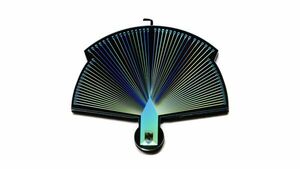
NASA’s Quantum Detector Achieves World-Leading Milestone
"A new JPL- and Caltech-developed detector could transform how quantum computers, located thousands of miles apart, exchange huge quantities of quantum data. Quantum computers hold the promise of operating millions of times faster than conventional computers. But to communicate over long distances, quantum computers will need a dedicated quantum communications network. To help form such a network, a device has been developed by scientists at NASA’s Jet Propulsion Laboratory and Caltech that can count huge numbers of single photons – quantum particles of light – with incredible precision. Like measuring individual droplets of water while being sprayed by a firehose, the Performance-Enhanced Array for Counting Optical Quanta (PEACOQ) detector is able to measure the precise time each photon hits it, within 100 trillionths of a second, at a rate of 1.5 billion photons per second. No other detector has achieved that rate." [...]
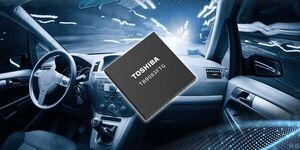
Toshiba's Newly Launched Gate-Driver IC for Automotive Brushless DC Motors Helps Improve Safety of Electrical Components
"Toshiba Electronic Devices & Storage Corporation ("Toshiba") has launched “TB9083FTG,” a gate-driver IC[1] for automotive brushless DC motors used in applications such as electric power steering (EPS), electric brakes and shift-by-wire. Volume shipments start today. Automotive equipment must deliver a performance that meets the requirements of ISO 26262, the functional safety standards for road vehicles. Semiconductor chips and electronic components installed in automotive equipment are no exception to this. The new product TB9083FTG controls and drives external N-channel power MOSFETs for driving a three-phase brushless DC motor. It is highly capable against the ISO 26262 2nd edition functional safety[2] and supports ASIL-D[3] for use in highly safety-critical automotive systems." [...]

Power over Ethernet (PoE) Switch Adds Advanced Network and Security Features for Outdoor Applications
"Microchip’s PDS-204GCO, the next-generation solution of the popular PDS-104GO, also offers easy installation and environmental protection. PoE switches designed for outdoor use in smart buildings and cities enable services ranging from public Wi-Fi® and video surveillance to connected streetlights that increasingly need better reliability and cybersecurity protection. Extending the industry’s family of PoE switches with the high industry-standard outdoor protection for these applications, Microchip Technology Inc. (Nasdaq: MCHP) today announces its PDS-204GCO switch that adds increased cyber protection plus the redundancy required for high network availability in mission-critical applications with long-distance connectivity. “Like our PDS-104GO switch, the PDS-204GCO complies with the high outdoor industry-standards, and is designed for easy and safe installation,” said Iris Shuker, director of Microchip's PoE business unit. “It also takes the next step to better support applications in which massive amounts of critical data are collected from widely dispersed PoE-powered edge IoT devices. It addresses these dual challenges of network security and network availability all the way from the endpoint to the central management system.” PoE technology enables power to be delivered over standard Ethernet infrastructure for quick and easy installation of edge IoT end points." [...]
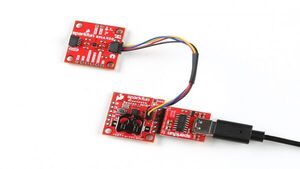
SparkFun Electronics, InPlay, and Bosch Sensortec partner to release two new NanoBeacon boards
"The new boards are ultra-low power, require no coding, and support Bosch Sensortec’s BME280 and BMA400 sensors In collaboration with InPlay and Bosch Sensortec, SparkFunⓇ is pleased to release two new IoT development boards: the SparkFun NanoBeacon™ Board - IN100 and SparkFun NanoBeacon Lite Board - IN100. The two versions allow for prototyping with the “Lite” version and then employing the production version in large installations once design is complete. These boards are great options for wireless sensor monitoring, asset tracking, retail beacons, or even making your own beacon tag for real time location monitoring. The boards feature the IN100 NanoBeacon from InPlay, which is Bluetooth® Low Energy compliant and transmits at a 2.4GHz frequency. Primary highlights include: - Low power: power consumption to below a microamp - allowing it to be left in the field sending data packets for multiple years on a coin cell battery. - Programming-free design: eliminates the need for embedded software programming; a PC configuration tool is provided to configure the IN100 device according to application needs." [...]

STMicroelectronics earns USB-IF certification for complete USB PD EPR solution; efficiently delivers up to 140W from a single adapter
"STMicroelectronics (NYSE: STM), a global semiconductor leader serving customers across the spectrum of electronics applications, has achieved USB-IF (USB Implementers Forum) certification of two ICs for use in adapter (source) and device (sink) sides of a USB Power Delivery (USB PD) EPR power supply/charger product. The new ICs extend the range of a universal charger to 140W. Now, a single AC to DC adapter can charge equipment such as computers, smart-home actuators, power tools, and e-bikes, as well as traditional applications including smartphones, tablets, and smartwatches. “Leading the way among semiconductor manufacturers, ST is now able to deliver USB-IF-certified reference designs and chips to meet customers’ demands for a high-power, industry-standard universal charger/adapter,” said Matteo Lo Presti, Executive Vice President Analog Sub-Group, Analog, MEMS and Sensors Group, STMicroelectronics. “By moving quickly to support USB PD EPR and achieve certification, we are accelerating the replacement of custom power plugs and DC barrels in numerous applications with a USB-C® connector. This allows charging with a universal AC or DC adapter, reducing cost and environmental impact.” Certified by the USB-IF to deliver up to 140W (28V@5A), the REF_STUSB140W (sink) and the ST-ONEHP (source) represent two halves of the complete USB PD reference design for the solution." [...]

Renesas Unveils Quick-Connect Studio: Industry’s First-Ever Cloud-based System Development Tool to Dynamically Create IoT Software
"Quick-Connect Studio Accelerates the Design Cycle by Enabling Customers to Build Rapid Prototypes and Develop Production-Level Software before Designing Hardware Renesas Electronics Corporation (TSE:6723), a premier supplier of advanced semiconductor solutions, today introduced a groundbreaking new online, cloud-based IoT system design platform that enables users to graphically build hardware and software to quickly validate prototypes and accelerate product development. Today’s development cycle is cumbersome – engineers research and define the project, collect device information and requirements, layout hardware, develop software, test, and iterate until the product is ready to release to market. This process is typically done sequentially, and each step takes a significant amount of time. Often the software development phase consumes the most engineering power and ultimately becomes the biggest bottleneck. With Renesas’ first-of-its-kind Quick-Connect Studio, engineers can now perform hardware and software development simultaneously. This is a radical shift in the industry, enabling designers to build software immediately with the ability to quickly reconfigure and test product ideas." [...]

TI's GaN technology and real-time MCUs power LITEON Technology's new server power supply design
"Adopting GaN and digital controllers in new designs helps engineers improve power density, conversion efficiency, dynamic response and reliability. Texas Instruments (TI) (NASDAQ: TXN), a leader in high-voltage semiconductor solutions, today announced that LITEON Technology has selected TI’s highly integrated gallium nitride (GaN) field effect transistor (FET) plus C2000TM real-time microcontrollers (MCUs) for its latest high-performance server power supply unit (PSU) for the North American market. Leveraging TI’s LMG3522R030 GaN FET and a TMS320F28003x C2000 real-time MCU, the newly commercialized PSU offers power density of over 95 W/in³ and meets 80 Plus Titanium standards. "Our collaboration with LITEON demonstrates how TI is helping designers answer the demands of high-voltage systems with end-to-end system know-how and a specialized portfolio of high-voltage semiconductors. By pairing the power of TI GaN products and C2000TM real-time MCUs, designers can better meet the demand for smaller, more reliable systems," said Luke Lee, TI’s vice president for Asia and president for Taiwan, Korea and South Asia. LITEON Technology is a global leading provider of power management solutions, offering highly-efficient power supplies for data centers." [...]

STMicroelectronics grows ST-ONE controller family for USB Power Delivery applications up to 140W
"STMicroelectronics has introduced the ST-ONEHP integrated digital controller, the world’s first IC certified by USB-IF according to the USB Power Delivery Extended Power Range (USB PD 3.1 EPR) specification. As the third controller in the ST-ONE family, the ST-ONEHP has 28V output capability to simplify building chargers and power adapters rated up to 140W. Sharing the ST-ONE architecture, the converter is a non-complementary active-clamp-flyback zero-voltage-switching (ZVS) topology that ensures superior efficiency at high power output and switching frequency. Essential features including secondary regulation and the USB PD communication interface are integrated, saving bill-of-materials costs as well as PCB size and complexity. Built-in synchronous rectification helps maximize efficiency and reinforced galvanic isolation permits a solution that is both compact and safe. Inside the ST-ONEHP, an Arm® Cortex®-M0+ microcontroller maintains overall control." [...]

Renesas Delivers 10 New Winning Combinations That Include Both Automotive and Non-Automotive Products
"Fully Tested Solutions Showcase Entire Renesas Portfolio; Address EV Charging, Vehicle Cluster Control and Other Applications. Renesas Electronics Corporation (TSE: 6723) today announced that it has introduced 10 new Winning Combinations that combine a broad range of products from Renesas entire portfolio, including both automotive and non-automotive parts. The new solutions address multiple applications for electric vehicle (EV) charging, instrument cluster control and low-voltage inverter functionality for traction motors. Renesas’ Winning Combinations are engineering-vetted designs that allow customers to take advantage of an elevated platform for their design ideas, accelerating product development cycles and lowering overall risk in bringing designs to market. Renesas now offers more than 300 Winning Combinations for a wide range of customers and markets. In November of 2022, Renesas announced a unified global sales and marketing organization, combining teams from the Automotive Solution Business Unit (ABU) and the IoT & Infrastructure Business Unit (IIBU) to accelerate cross-BU collaboration." [...]
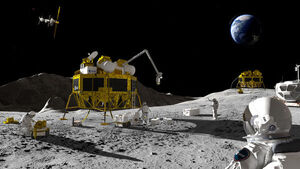
Telling time on the Moon
"A new era of lunar exploration is on the rise, with dozens of Moon missions planned for the coming decade. Europe is in the forefront here, contributing to building the Gateway lunar station and the Orion spacecraft – set to return humans to our natural satellite – as well as developing its large logistic lunar lander, known as Argonaut. As dozens of missions will be operating on and around the Moon and needing to communicate together and fix their positions independently from Earth, this new era will require its own time. Accordingly, space organisations have started considering how to keep time on the Moon. Having begun with a meeting at ESA’s ESTEC technology centre in the Netherlands last November, the discussion is part of a larger effort to agree a common ‘LunaNet’ architecture covering lunar communication and navigation services. Architecture for joint lunar exploration “LunaNet is a framework of mutually agreed-upon standards, protocols and interface requirements allowing future lunar missions to work together, conceptually similar to what we did on Earth for joint use of GPS and Galileo,” explains Javier Ventura-Traveset, ESA's Moonlight Navigation Manager, coordinating ESA contributions to LunaNet." [...]
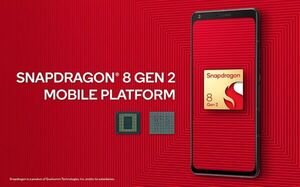
Qualcomm and Thales Unveil World’s First GSMA Compliant iSIM with Latest Snapdragon Mobile Platform
"Leading industry innovators, Qualcomm Technologies, Inc. and Thales, announce the certification of the world’s first commercially deployable iSIM (Integrated SIM) on the Snapdragon® 8 Gen 2 Mobile Platform, enabling the functionality of a SIM within a smartphone’s main processor. GSMA’s (Global Association for the Mobile Communications Industry) security certification2 ensures that the iSIM supports the same high standards of cyber-protection and flexible ‘anytime anywhere’ connectivity offered by the latest generation of embedded SIMs (eSIMs). The new iSIM can now offer device makers further opportunities to save space and reduce build and supply chain costs while maintaining best-in-class security level. Just like Thales’ eSIM, the new iSIM is fully compliant with the GSMA Remote SIM Provisioning standard; meaning its subscriptions are remotely manageable through any standard platforms. The emerging iSIM form factor complements existing SIM and eSIM designs, and research suggests the market share to grow to 300 million by 2027, representing 19% of all eSIM shipments, according to Kaleido Intelligence. “We are very pleased to see our investment in high assurance processor hardware security, in collaboration with Thales, achieving the security and functional bar required by the GSMA for Remote Provisioning UICC use case." [...]
Ciência e Tecnologia
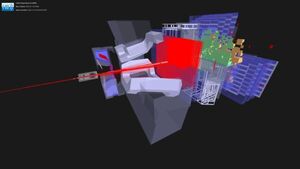
LHCb begins using unique approach to process collision data in real-time
"Using a new system called real-time analysis, the LHCb collaboration has made filtering and analysing experiment data simpler and faster. Current technology does not allow all Large Hadron Collider (LHC) proton–proton collision data to be stored and analysed. It is therefore necessary to filter out the data according to the scientific goals of each experiment. Physicists call this selection process the “trigger”. Thus, data taking and analysis at the LHC has traditionally been performed in two steps. In the first, which physicists call “online”, the detector records the data, which is then read out by fast electronics and computers, and a selected fraction of the events is stored on disks and magnetic tapes." [...]
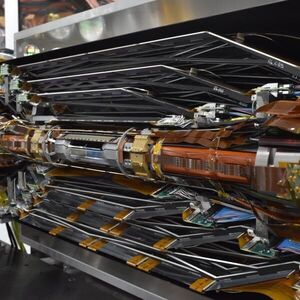
Artificial intelligence for rapid simulation of data
"Physicists at LMU play major role in new collaboration on digitalization in basic scientific research. LMU physicists Thomas Kuhr and Jochen Weller are collaborating with researchers from all over Germany in the KISS project. Funded by the German Federal Ministry of Education and Research, KISS was launched to develop AI-based simulation processes that facilitate the more rapid, more flexible, and more efficient evaluation of research data compared to conventional methods. The algorithms make it possible, for example, to pool together and abbreviate complex incremental simulations of subprocesses with their predictions. Such efficiency gains are necessary, because particle detectors and telescopes are already generating large data volumes that require huge computing resources to evaluate. And now the expansion in the size of detectors and telescopes is pushing computing capacities to their limits." [...]
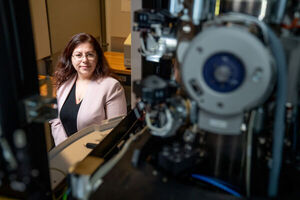
A closer look at the nanoscale and beyond
"Materials scientist Anna Osherov helps researchers comprehend the nanoscale down to an atom using MIT.nano’s characterization tools. Stroll past MIT.nano, the Institute’s center for nanoscience and engineering, and you can peer through large panes of glass at hundreds of tool sets ready to assist researchers in their scientific journey. Anyone who wants to take a closer look at what is happening at the nanoscale and beyond — even seeing individual atoms — will be welcomed by Anna Osherov, assistant director for Characterization.nano, helping researchers navigate a complex array of capabilities to apply the power of nanotechnology to new discoveries and next-generation technologies. Osherov was among the first to join MIT.nano’s staff when it opened in 2018. Her purview encompasses instrumentation for metrology, imaging, and precise nanoscale analysis. This includes state-of-the-art technologies such as electron microscopy and spectroscopy, as well as instruments that measure mechanical, electrical, magnetic, and topographic properties." [...]
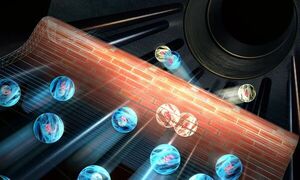
Quantum Chemistry: Molecules caught tunneling
"Physicists led by Roland Wester of the University of Innsbruck have now for the first time observed a quantum mechanical tunneling reaction in experiments. The observation can also be described exactly in theory. With the study published in Nature, the scientists provide an important reference for this fundamental effect in chemistry. It is the slowest reaction with charged particles ever observed. Tunneling reactions in chemistry are very difficult to predict. The quantum mechanically exact description of chemical reactions with more than three particles is difficult, with more than four particles it is almost impossible." [...]
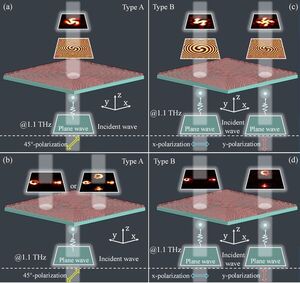
Researchers create metasurface that enables multichannel terahertz transmission
"Tiny metasurface devices could help improve communication, terahertz imaging, manipulating particles and encoding of quantum information. Researchers have designed and demonstrated two all-silicon terahertz metasurface devices that can be used to create four optical channels for simultaneously implementing different optical functions. This capability could be useful for a variety of applications such as communication, terahertz imaging, particle manipulation or encoding quantum information. The new technology could, for example, help ease the transition to faster 6G wireless networks, which will likely be based on high frequency waves such as those in the terahertz region. “6G networks will likely require more base stations to achieve full signal coverage,” said research team leader Fuyu Li from the University of Electronic Science and Technology of China. “The multiple channels produced by our devices could be used to simultaneously achieve beam deflection at multiple frequencies, which would reduce the need for more base stations and accelerate the arrival of 6G communications.” In the Chinese Laser Press and Optica Publishing Group journal Photonics Research, the researchers describe the new devices, which represent a completely new method for superimposing various forms of terahertz waves, including focused, spherical and vortex waves." [...]
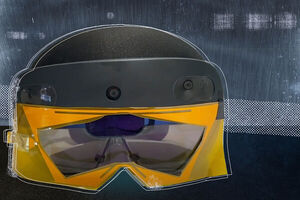
Augmented reality headset enables users to see hidden objects
"The device could help workers locate objects for fulfilling e-commerce orders or identify parts for assembling products. MIT researchers have built an augmented reality headset that gives the wearer X-ray vision. The headset combines computer vision and wireless perception to automatically locate a specific item that is hidden from view, perhaps inside a box or under a pile, and then guide the user to retrieve it. The system utilizes radio frequency (RF) signals, which can pass through common materials like cardboard boxes, plastic containers, or wooden dividers, to find hidden items that have been labeled with RFID tags, which reflect signals sent by an RF antenna. The headset directs the wearer as they walk through a room toward the location of the item, which shows up as a transparent sphere in the augmented reality (AR) interface. Once the item is in the user’s hand, the headset, called X-AR, verifies that they have picked up the correct object." [...]
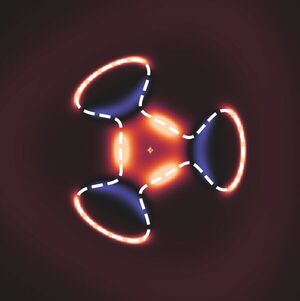
Reaching Superconductivity Layer by Layer
"New topological superconductivity in multilayered graphene sheets Graphene is a strange material. Understanding its properties is both a fundamental question of science and a promising avenue for new technologies. A team of researchers from the Institute of Science and Technology Austria (ISTA) and the Weizmann Institute of Science has studied what happens when they layer four sheets of it on top of each other and how this can lead to new forms of exotic superconductivity. Imagine a sheet of material just one layer of atoms thick—less than a millionth of a millimeter. While this may sound fantastical, such a material exists: it is called graphene, and it is made from carbon atoms in a honeycomb arrangement. First synthesized in 2004 and then soon hailed as a substance with wondrous characteristics, scientists are still working on understanding it." [...]
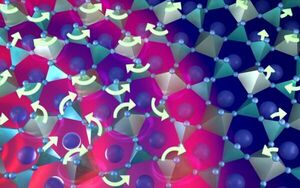
Neutrons reveal key to extraordinary heat transport
"Warming a crystal of the mineral fresnoite, Oak Ridge National Laboratory scientists discovered that excitations called phasons carried heat three times farther and faster than phonons, the excitations that usually carry heat through a material. "Neutrons were ideal for exploring these sources of heat transport because they interact with both phasons and phonons," said Michael Manley, who led the study with Raphael Hermann. In most crystals, atomic vibrations propagate excited waves through the lattice as phonons. However, in certain crystals, atomic rearrangements also propagate excited waves as phasons. Because phasons can move faster than sound, physicists anticipated they would excel at moving heat. The team mapped paths of phasons and phonons and characterized their vibrations at ORNL's Spallation Neutron Source and measured the transport of heat through the lattice in a Materials Science and Technology Division laboratory." [...]
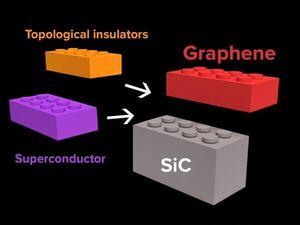
New material may offer key to solving quantum computing issue
"A new form of heterostructure of layered two-dimensional (2D) materials may enable quantum computing to overcome key barriers to its widespread application, according to an international team of researchers. The researchers were led by a team that is part of the Penn State Center for Nanoscale Science (CNS), one of 19 Materials Research Science and Engineering Centers (MRSEC) in the United States funded by the National Science Foundation. Their work was published Feb. 13 in Nature Materials. A regular computer consists of billions of transistors, known as bits, and are governed by binary code ("0" = off and "1" = on). A quantum bit, also known as a qubit, is based on quantum mechanics and can be both a "0" and a "1" at the same time. This is known as superposition and can enable quantum computers to be more powerful than the regular, classical computers." [...]
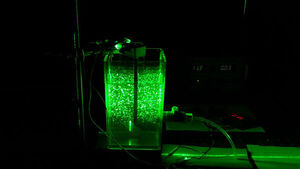
Researchers uncover new water monitoring technique
"Water is a vital resource, and clean water is a necessity. Texas A&M University researchers have developed a new technique to monitor one of the key processes of purifying water in real time. Raw water contains microscopic pathogens that are too small to remove during water and wastewater treatment easily. Chemicals are added to form large clumps called flocs, which are easily filtered out. Flocculation is the process used in water treatment to remove suspended particles from the water. "Coagulant chemicals need to be added to purify drinking water and remove turbidity (cloudiness) and microbes that are too small to be visible to the naked eye," said Dr. Kuang-An Chang, professor in the Zachry Department of Civil and Environmental Engineering at Texas A&M." [...]

BasePairPuzzle: A New Way to Teach Students About Nucleobase Pairing
"Novel 3D-printed molecular model of the five nucleobases uses embedded magnets to accurately represent intermolecular interactions Molecular models can be a great tool to teach chemistry and biochemistry, but most of them cannot accurately depict intermolecular interactions, such as hydrogen bonds. In a recent study, researchers developed a 3D-printed molecular model called BasePairPuzzle, which uses embedded neodymium magnets to accurately mimic intermolecular interactions between the five nucleobases. This model provides an intuitive, hands-on experience to help students understand base pairing, as well as concepts such as DNA mutations and the double helix. Molecular models are a tried-and-tested tool for teaching chemistry to students of all ages. By enabling users to visualize the three-dimensional structure of a molecule and how its atoms are arranged, they can accelerate the learning process for essential topics such as covalent bonds. In biochemistry classes, molecular models of DNA are a popular way to teach students about nucleobase pairing and how the iconic double-stranded helical structure looks." [...]

Physicists Use Quantum Mechanics to Pull Energy out of Nothing
"For their latest magic trick, physicists have done the quantum equivalent of conjuring energy out of thin air. It’s a feat that seems to fly in the face of physical law and common sense. “You can’t extract energy directly from the vacuum because there’s nothing there to give,” said William Unruh, a theoretical physicist at the University of British Columbia, describing the standard way of thinking. But 15 years ago, Masahiro Hotta, a theoretical physicist at Tohoku University in Japan, proposed that perhaps the vacuum could, in fact, be coaxed into giving something up. At first, many researchers ignored this work, suspicious that pulling energy from the vacuum was implausible, at best. Those who took a closer look, however, realized that Hotta was suggesting a subtly different quantum stunt." [...]

Bouncing seismic waves reveal distinct layer in Earth's inner core
"Data captured from seismic waves caused by earthquakes has shed new light on the deepest parts of Earth’s inner core, according to seismologists from The Australian National University (ANU). By measuring the different speeds at which these waves penetrate and pass through the Earth’s inner core, the researchers believe they’ve documented evidence of a distinct layer inside Earth known as the innermost inner core – a solid ‘metallic ball’ that sits within the centre of the inner core. Not long ago it was thought Earth’s structure comprised four distinct layers: the crust, the mantle, the outer core and the inner core. The findings, published in Nature Communications, confirm there is a fifth layer. “The existence of an internal metallic ball within the inner core, the innermost inner core, was hypothesised about 20 years ago. We now provide another line of evidence to prove the hypothesis,” Dr Thanh-Son Phạm, from the ANU Research School of Earth Sciences, said." [...]
Projetos Maker
Diversos Projetos interessantes.

Ovrdrive
"Ovrdrive is a purpose built security focused usb drive. If the user doesn't lick their fingers while inserting the drive it will appear completely blank. It is entirely open source and all the tools used to build it are open source. There is a blog series listed below with more information for the curious. Parts ATTINY24A-CCUR - BGA version ATTINY24-20PU - DIP version K9gag08u0e-Scb0 - NAND Flash SM3255AA - What dmesg thinks the chip is SM3257EN - Part number on the chip SM3257ENAA - Reported by SMI Mass Production Tool 838-22-004-10-001101" [...]
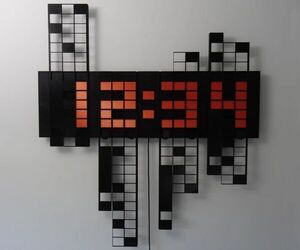
Time Slider
"A digital clock using sliding grids to show or hide the segments of the digits. Each minute the sliders move in a synchronized manner to show the current time. The clock is powered by an Arduino Mega and it uses a DS3231 RTC to keep the time. Each digit has two sliding grids which are affected by small stepper motors. I designed it with Autodesk Fusion 360 and 3D printed it on a Prusa MK3S. Supplies - Arduino Mega - DS3231 Real Time Clock Module - Eight stepper motors 28BYJ-48 with ULN2003 Driver - 82 cm Wooden strip 19x19mm - Steel Wire 1m - 46 Washer head screw 4.2 x 14 mm - 16 Button head screw and nut M4 x 10 - 18 self tapping screws M3 x 5 - Dupont Wires - 5V power cable with DC plug 5.5x2.1mm - Power supply 5V/2A - Power supply for the Arduino Mega" [...]
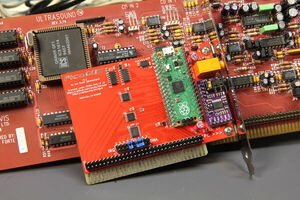
PicoGUS
"ISA sound card emulation on the Raspberry Pi Pico's RP2040 microcontroller. PicoGUS can emulate: - Gravis Ultrasound (GUS) - the primary focus of PicoGUS, hence the name - AdLib (OPL2) - MPU-401 (with intelligent mode) - outputs MIDI data on 3.5mm MIDI TRS connector - Tandy 3-voice - CMS/Game Blaster Current status: Beta! See the main wiki page for current status and the compatibility list for support status of various DOS programs and other system compatibility notes. This project has a heavy demoscene focus due to the GUS's history so that's what I've concentrated on, but GUS support in games is quickly improving. Want to make your own beta PicoGUS? See the build guide." [...]
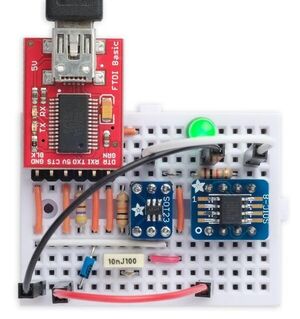
Tiny UPDI-HV Programmer
"This is a simple High-Voltage UPDI programmer, for programming 0-series, 1-series, and 2-series ATtiny chips to allow you to configure the UPDI pin as a extra general I/O pin. For simplicity it is designed to work with an existing USB to Serial board, and an external 12V source. Introduction The ATtiny 0-series, 1-series, and 2-series chips allow you to get an extra I/O pin by reprogramming the UPDI pin as a general I/O pin. However, the downside is that you can't subsequently use a regular UPDI programmer to reprogram the chip. Microchip provide a reset mechanism, which involves applying a short pulse to the UPDI pin before programming it. Although the method is called 'High-Voltage Activation', the pulse is actually only 12V, slightly higher than the normal 3.3V or 5V voltage level." [...]

EverythingUSB - USB that has it all!
"Introducing EverythingUSB module - USB C connector, castellated, overcurrent & ESD protection, single-cell battery charging, and more. Are you tired of dealing with messy wires and unreliable connections? Say hello to EverythingUSB module! - A USB-C type connector configured for a fixed 5V output, with ESD protection on data lines - VCC supply is overcurrent protected, through a 500mA fuse - ESD protection on all UART pins, providing an additional layer of protection against electrostatic discharge that can damage sensitive components. - Single cell battery charging with up to 1A current, allowing you to quickly and easily charge your device without the need for an external power supply. - Charging status LEDs that let you know when your battery is fully charged and ready to go." [...]

315MHz Jammer with Arduino and fs1000a
"315Mhz jammer with Menu This project is about a jammer in the 315MHz band, the frequency of the jammer can be changed using the menu. Features - Disruptor in the 315 MHz band - Frequency control using the menu Getting Started We use Oled SSD1306, 315MHz Transmitter and Arduino. - Oled SSD1306 0.96" - Arduino Nano - 315MHz Transmitter - Micro Switch" [...]

Basic RP2040 room temperature display
"A small, simple, and easy to use, room temperature sensor. It measures and displays temperature on an SSD1306 LCD. All powered by a battery This project is about building your own room temperature display with the Xiao RP2040 from Seeed Studios. The Xiao series of MCU's are small packaged but they pack a punch!! This project relies heavily on the Xiao RP2040 as it consumes little power, has great accuracy thanks to the RP2040 microprocessor, and a cost effective price of under $6. There are more processor variants available like, ESP C3, and Realtek!!" [...]
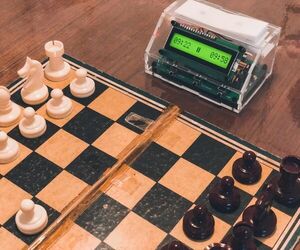
Arduino Nano Chess Clock
"Have you also been pulled into the world of chess, after it got extremelypopular? Either way it got me the inspiration to make this digital chess clock, powered by an Arduino Nano, and displayed using a LCD display. The clock can be powered by 5V from three AAA batteries making it portable, or 5V directly from a micro usb cable, with at least 1.5A, for those longer games. In this guide I will show you how I build it and how you can too. Supplies: - An Arduino Nano and a compatible USB cable with data lines - A 16x2 or 16x1 LCD display (Can be I2C, but not required) - 3x 90 angle push buttons - 1x 90 angle 2-way switch - 4x 220 Ω Resistors - Short jumper cables/wires - Copper foil tape - 4x 5mm magnets - 8x 5mm standoffs with nuts and screws - A bit of superglue - Optional: - 3x AAA batteries and SMD AAA battery holders - Micro USB breakout board - Female and male pin headers Tools: - 3D-printer - Soldering iron and solder - Wire-cutter - A Phillips Head Screwdriver - A Computer - Optional: - PCB-holder and/or a third helping hand" [...]
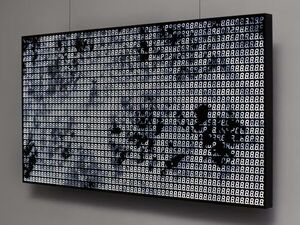
Sea of Segments
"1536 seven segment displays that show videos of water I've always loved the seven segment display. It probably started because they were on pretty much every applicance when I was a kid, but as I got older I admired their brutal efficiency at displaying numbers. One day, I had the idea to build a display made from them. PCB The starting point was a modular PCB that can pass data in two directions. Each PCB has 32 digits in a 2 x 4 grid of 4 digit seven segment displays. The LEDs in the displays are driven by two TLC5920 drivers." [...]

PICMorseClock
"A PIC16 based Morse Code Clock It will blink green once a second, on the top of every minute will blink the hours in blue and the minutes in red following the morse code pattern for numbers, if picked up the tilt sensor will be activated and the alien tune from Close Encounters will play on the buzzer, followed by a multitude of colors blinking on the RGB led. Parts list: - PIC16F1827 - DS1037 RTC - NBR18650B Li-Ion Battery - 18650 battery holder - TP4056 charging module - Piezo buzzer - 10mm RGB led - Resistors (3 x 150, 100 and 10k Ohms) - Tilt switch" [...]
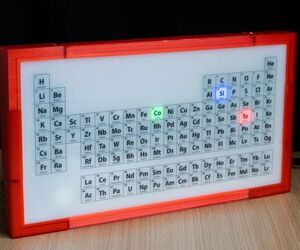
Periodic Table Clock
"In this guide, you'll learn how to create a unique clock that displays the time with the atomic numbers of elements on the periodic table. By illuminating specific elements on the table, time is represented in hours, minutes, and seconds. If you are familiar with the periodic table or the atomic numbers of the elements, you can tell the time from far away just by seeing the elements! How Is the Time Displayed? The time is displayed using 3 colors Blue, Green, and Red representing hours, minutes, and seconds. If Oxygen is illuminated Blue, and Neon is illuminated Green it means the time is 8h:10m or in other words Neon past Oxygen!" [...]
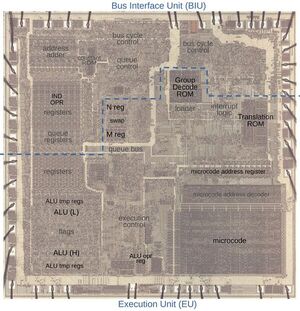
Reverse-engineering the ModR/M addressing microcode in the Intel 8086 processor
"One interesting aspect of a computer's instruction set is its addressing modes, how the computer determines the address for a memory access. The Intel 8086 (1978) used the ModR/M byte, a special byte following the opcode, to select the addressing mode.1 The ModR/M byte has persisted into the modern x86 architecture, so it's interesting to look at its roots and original implementation. In this post, I look at the hardware and microcode in the 8086 that implements ModR/M2 and how the 8086 designers fit multiple addressing modes into the 8086's limited microcode ROM. One technique was a hybrid approach that combined generic microcode with hardware logic that filled in the details for a particular instruction. A second technique was modular microcode, with subroutines for various parts of the task. I've been reverse-engineering the 8086 starting with the silicon die." [...]

Artificial Life 2
"A vastly enhanced version of my Artificial Life project; with extra parameters, behaviours and LED panel compatibility. Previously... In 2017 I made a project called Artificial Life which used an 8x8 Unicorn matrix to display a grid of Artificial Lifeforms that would breed and fight each other. In 2022 I updated the project to Artificial Life HD - which used a 16x16 Unicorn matrix as well as enhanced code, bug fixes and some extra functionality. And so here we are in 2023 with 64x32 LED Panel compatibility and a whole ton of extra bug fixes, enhancements/added functionality and optimisations with Artificial Life 2! Lets dive in." [...]
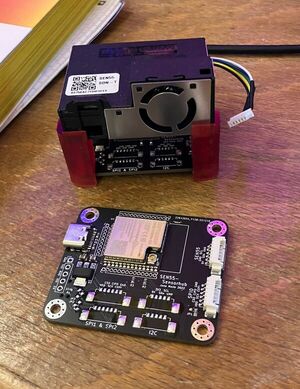
anotter-sensor-hub
"This is an ESP32-based environmental sensor hub that comes with a Prometheus interface. It is designed to work perfectly with Sensirion SEN05x sensors, such as the depictured SEN055. These sensors provide PM1, PM2.5, PM4, PM10, temperature, humidity, VOC, and NOC indices. In addition, other I2C, SPI, or PWM sensors can be added to the designated connectors. All ESP32 pins are broken out, allowing you to connect any sensor imaginable to the host board. The PCB and components (w/o SEN055) are about ~5$, with SEN055 it comes up to ~40€/sensor node." [...]
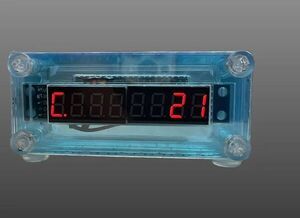
Class Countdown Clock With Raspberry Pi Pico W and MQTT
"A countertop device that counts down to the end of the current class period while a class is active, and then count down to the start of the next class between periods. Clocks are managed through an MQTT server running on a Linux device. These clocks automatically follow the correct schedule and events based on an iCalendar schedule, so they still work for special schedules. The ultimate goal of the project was to help teachers manage their class time more efficiently. Supplies Materials Per Clock (Please see the attached pdf for much more in-depth details on the materials): - 1x Raspberry Pi Pico W - 1x 5V 2.5A Power Supply with MicroUSB cable - 1x 8 digit Max7219 7-segment display - 5x Female to Female Jumper Wires (75 mm) - 4x 40 mm M5-0.8 Clear Nut and Bolt Set - 4x Rubber Feet Pads - 2x 10 Pin 2.54 Pitch Male Headers - If laser cutting: - 0.0625" clear cast acrylic - 0.125" opaque cast acrylic 1 Server: - Raspberry Pi 4, old laptop, or anything that can connect to the internet and run a distribution of Linux - Accessories needed to power/access the server Supplies: - Lead-Free Solder - Example: 0.8mm Lead Free with Rosin Core Tools: - MicroUSB to USB cable to set up the Pico W's software - Phillips-Head Screwdriver - Soldering Equipment - Soldering Iron (Get a decent one) - Solder Sucker (For inevitable mistakes) - Solder Fume Extractor (recommended) - Breadboard - Big enough to fit a Raspberry Pi Pico W to help with soldering it - Example: Half-Size Breadboard with Mounting Holes - A small amount of masking tape, around 4" (10.16 mm) - Pliers (for splitting male headers) - Laser Cutter or 3D Printer" [...]
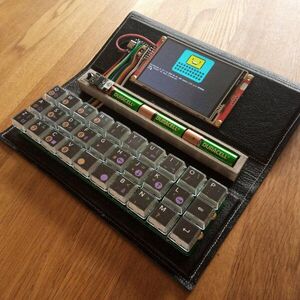
Vt2040
"Portable serial terminal Portable serial terminal, based on an RP2040 with a Gherkin keyboard and an ILI9488 screen. A portable serial terminal based on an RP2040 dev board, with some hopefully reusable bits of code: * A 6x13-pixel antialiased bitmap font. * A small but full-featured terminal emulator. * A matrix keyboard driver with tap/hold functions. * An ILI9488 SPI LCD driver. * A PIO serial interface." [...]

HEXA LEDs - Bluetooth Controlled Glowing Hexagons
"With this instructables (my very first one ! ), I propose to you to make this glowing HEXA shaped light for your living room or for your gamer boy's room. As you can see, I was in that last case ;-). The thing is, you can design your own pattern to fit your wall(s), ceiling or whatever surface to cover. Small one, giant one, everything is possible, thanks to the unique modular piece. The light panel is controlled by an android app (sorry for the Apple ones !)" [...]

How the 8086 processor determines the length of an instruction
"The Intel 8086 processor (1978) has a complicated instruction set with instructions ranging from one to six bytes long. This raises the question of how the processor knows the length of an instruction.1 The answer is that the 8086 uses an interesting combination of lookup ROMs and microcode to determine how many bytes to use for an instruction. In brief, the ROMs perform enough decoding to figure out if it needs one byte or two. After that, the microcode simply consumes instruction bytes as it needs them. Thus, nothing in the chip explicitly "knows" the length of an instruction. This blog post describes this process in more detail." [...]
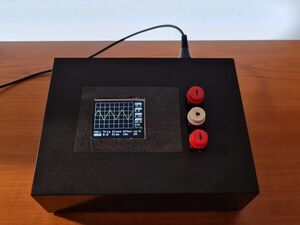
pillScope Plus
"Oscilloscope based around the STM32F401 Black Pill and a color LCD screen, meant to be used as an educational tool Why does it exist? The goal of this project was to create a simple and easy to build but still very usable oscillsocope. I wanted to learn the basics of how a digital storage oscilloscope functions, while also ending up with something which can be used as an educational tool in the lab. A short description of how oscillscopes (and this one in particular) work can be found here. Features - -3.3V to 3.3V input range (can be increased if using attenuator probes) - 1MOhm input impedance - 10uS/div minimum timebase - 1.6 MSa/S sampling rate - On screen measurements: - min/max voltage - peak-to-peak voltage - frequency - Captured waveforms can be sent to a computer over UART and analyzed in the Tektronix TekScope app Required parts Base parts: - STM32F401CC Black Pill development board - 128x160 ST7735-based TFT display - 3 pushbuttons - LM358 dual op-amp (rail-to-rail opamps should work better in this context, but this is what I had on hand) - 2x 68kOhm resistors (to create a 1.65V offset voltage) - 2x 500kOhm resistors (to create the input attenuator) Useful, but not mandatory: - a 5V power supply - an opto-isolated USB UART adapter - a BNC connector, for using proper oscilloscope probes" [...]
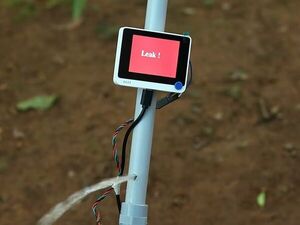
Fluid Leakage Detection With AI
"Identify leaks by using machine learning and a flowmeter to measure and classify the flow of liquid through a pipe. Fluid leakage in industrial pipelines can have serious and potentially destructive effects on both the environment and human health. One of the most significant impacts of fluid leakage is the potential for contamination of soil and water sources. Many industrial fluids, such as oil and chemical compounds, are toxic and can have devastating effects on the ecosystems they come into contact with. For example, an oil spill can contaminate soil and water, leading to the death of plants and animals that depend on these resources. The cleanup process for such a spill can also be expensive and time-consuming, with long-term consequences for the affected area." [...]
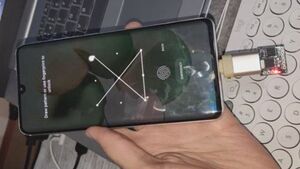
DigiCombo
"You no longer need to waste your time on simple and repetitive tasks and you can save it for hard tasks that have a lot of value just only prepare the necessary inputs that include the coordinates and the text to be printed, leaving the rest to Digispark Attiny 85. It uses V-USB and HID protocol for inject touch events and keystrokes that your Digispark recognized by your system as an external touchs creen and a keyboard The operating systems in which it works correctly: - Android - Windows 10" [...]
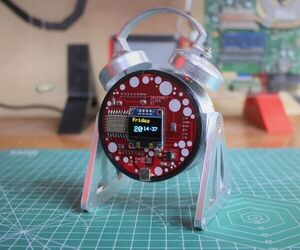
Digital Clock From 1800s (not Really)
"Hi guys, how are you doing today? Well, today's interesting item is a metal alarm clock from the 1800s that uses modern hardware and obtains time from the internet. The goal was to create a desk clock that resembles the traditional metal alarm clocks that have been around for more than 200 years. It has the same design as a traditional metal alarm clock and even has bells with a handle and a stand. The custom ESP12F-powered circuit at the center of this project shows the time obtained by the ESP12F when it connects to the internet using an NTP client. It also contains an SSD1306 OLED display and a few other necessary components." [...]

Make a Vintage Looking Wooden Digital Clock
"This is an old looking vintage digital clock. This clock is made up of wood and completely digital. This clock can run for about a week (7 consecutive days) in a single charge. It uses an ATmega328P microcontroller which uses Arduino IDE for programing. Supplies - Arduino UNO (for testing purpose only) - ATmega328P - DS1307 RTC Module - Dot Matrix Display Module - Push Buttons - TP4056 Charging module - Lithium ion battery" [...]

Back-to-the-Future: Twin Pines Mall Clock
"Clocks are one of the main themes in "Back to the Future" - and also some of my favorite items for building replica props. Previously, I built three of those clocks, the one in the Time Circuits, the Harold Lloyd clock (as seen in the beginning of part I in Doc's house), and one with Marty and the Doc standing in front of the clock face (based on a photo featured in BTTF part III). Part I of BTTF also features another important clock which is part of the "Twin Pines Mall" sign (which, after Marty changed the timeline, became the "Lone Pine Mall"). This is the one I'm building here. The electronics is built around an Arduino Nano. When bought from a Chinese supplier, the total cost of the electronics components should be below $20." [...]

DIY Lakhovsky MWO (Milti Wave Oscollator) Device, Detailed Informations, Facts, Analysis
"Georges Lakhovsky was a Russian scientist wich is best known for his work on device he claimed could cure diseases such as cancer by exposing cells to a combination of radio frequencies. Supplies - Fluorescent lamp ballast (one or two , 370mA-740mA) - UF5408 or similar ultrafast diode - 1 microF/400v MKP capacitor - IRFP450 or similar Mosfet Transistor - 12v/1w Zener diodes - 2pcs - Rotary Potentiometer, 10 kohm - 12 kOhm 1/2w resistor - coils (primary and secundary) - Lakhovsky Antenna" [...]
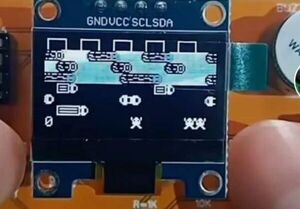
Attiny 85 Game
"See how I have made my own PCB for the well-known ATtiny85 Arcade game circuit. Here you will have the schematic, parts list, step by step of soldering components, how to burn bootloader and how to upload codes for different games to the ATtiny85. The connections are very easy. The ATtiny has 6 pins taht we could use and a supply of 3V from the battery and GND pin. Don't worry, the chip works fine at 3V and the same for the rest of the components. The buttons have a pulldown and are conencted to pins PB0, 2 and 5." [...]
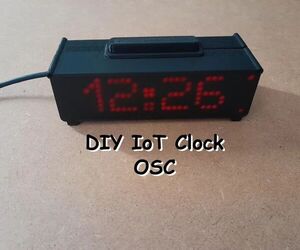
DIY Smart Home Clock - OSC
"Welcome, in this instructable we will show you how to create a simple smart home clock with a dot matrix display. The name OSC is short for "overengineered simple clock". The goal was to add multiple sensors and IoT functionality. However, the small Esp8266 Chip has limited pins, so only two sensors were added: temperature (DHT11), microphone (MAX4466). A custom pcb was designed to simplify the wiring process and reduce the effort to replace broken parts. The repository contains everything to get started, from the code to the documents and stl files." [...]
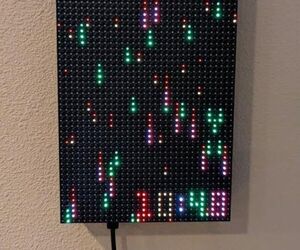
64x32 LED Matrix Clock
""I DONT EVEN SEE THE CODE ANYMORE" - The Matrix. Here we have a clock that presents the current time on an 64x32 RGB LED using a "Matrix-like" falling particle effect. The clock also offers other presentation styles, including an "advanced" matrix that does not show the numbers (you can learn to read the clock based on colors and particle speeds). Although the images above give you a basic idea, they can't show you the dynamic range of the LED or the visual impression of 200 FPS animations, The project's firmware is designed to easily incorporate support for other hardware configurations. Included in the code is an 8x8 "Dotstar" matrix version that was my first version. This documentfocuses on the newer 64x32 model, which I prefer." [...]

Ultrasonic Air Drums
"I've always been a fan of air instruments where you make music without touching anything so when DFRobot offered to send some sensors so I can make a project with them, I pitched the idea of making a set of Air Drums. An Air Drum is a device where you can make a rhythm without actually hitting any surface and for that, I'm using ultrasonic sensors that detect when my hands get close enough to the sensor. The project is based on the URM09 sensors from DFRobot as well as their FireBeetle ESP32 development board that has WiFi, Bluetooth, and an onboard lithium charging circuit so the entire drum kit can be made portable. You can check out the DFRobot store here: https://www.dfrobot.com/ Below is a list of all the DFRobot sensors and controllers used in the video: - URM09 Ultrasonic sensor - FireBeetle ESP32 IoT Microcontroller - Gravity I/O Expansion Shield - Gravity: I2C HUB - DFPlayer Pro - A mini MP3 Player - MAX98357 I2S Amplifier Module - Stereo Enclosed Speaker - Gravity: Voice Recorder Module" [...]
Secção Videos
Videos interessantes.
That's all Folks!







